Congregation Habonim Toronto
Congregation Habonim Toronto, founded in 1954, is a liberal reform synagogue located at 5 Glen Park Avenue in Toronto, Ontario, Canada, and one of the first Holocaust refugee/survivor congregations to develop in Canada.[1] Although currently independent of any official denomination, its early founders modeled the synagogue on the example of early Reform Judaism in Germany.
| Congregation Habonim of Toronto | |
|---|---|
| Religion | |
| Affiliation | Judaism |
| Province | Ontario |
| Ecclesiastical or organizational status | Active |
| Location | |
| Location | Toronto, Ontario, Canada |
| Municipality | Toronto |
 Location in Toronto | |
| Geographic coordinates | 43°42′46″N 79°25′46″W |
History
The early members of Habonim (literally "the builders") were Holocaust survivors or refugees from Central Europe, who arrived in Canada after World War II.[2]
One of its founders and first President was George Spitz, a Jewish refugee from Berlin, who unsuccessfully attempted to bring over his family from Germany in 1939 on the ill-fated MS St. Louis.
Paul Alexander, also a refugee of Berlin, was an early Vice-President of the synagogue - his twin brother Hanns was most famous for capturing Rudolf Höss, the Kommandant of Auschwitz.[3] Both served as officers in the British Army during World War II and, given their fluency with the German language, were in charge of German POWs at the war's close.
The first High Holiday services were held in 1954 in rented premises downtown, but by 1958 they were renting space from the Judaea Lodge of the Knights of Pythias,[4] a non-sectarian branch of an American organization started during the U.S. Civil War and established in Toronto 1927. This rented space in uptown Toronto was located at its current site near Bathurst and Glencairn. The building was purchased outright by the Congregation in 1968.[5]
Notable figures
Some of the notable figures associated with the Congregation are Esther Ghan Firestone,[6] the first female cantor in Canada, Rabbi Reuben Slonim (1914–2000) (author, and also associate editor of The Toronto Telegram), known for his outspoken views on the Israeli-Arab conflict,[7] Cantor Henry Weingluck,[8] a well known artist who was a pupil of Max Liebermann, and Avrum Rosensweig,[9] founder of Ve'ahavta,[10] the Canadian Jewish Humanitarian Relief Organization. Since 1988, its religious leader has been writer and filmmaker Eli Rubenstein, leader of the Canadian March of the Living and March of Remembrance and Hope programs.
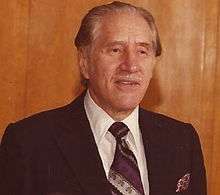
The Habonim Youth Choir
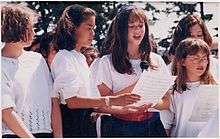
The Congregation also supports a choir, the Habonim Youth Choir,[11] whose recording of the peace song Lay Down Your Arms (Doron Levinson song) has received international exposure. The choir was founded in 1990 by Habonim's cantor Esther Ghan Firestone and the synagogue's religious leader Eli Rubenstein. The choir's current conductor is Habonim cantor Aviva Rajsky, and its accompanist is Tom Bellman. The choir, which presently also includes adults, is now called, "The Habonim Choir."
The choir's rendition of Lay Down Your Arms[12] was featured on Fern Levitt's documentary, Gorbachev's Revolution.[13]
Their recording of the Holocaust song, Eli, Eli[14] (lyrics by Hannah Szenes), and "The Song of the Vilna Partisans" (Zog Nit Keyn Mol) appeared on David Kaufman's 2003 documentary, From Despair to Defiance, commemorating the 60th anniversary of the Warsaw Ghetto Uprising.[15] Eli, Eli also appeared on the short documentary "To Live and Die with Honor" commemorating the 70th anniversary of the Warsaw Ghetto Uprising.[16] On May 22, 2014, the Habonim Youth Choir opened up for the legendary Puerto Rican virtuoso blind guitarist & singer, Jose Feliciano, at a Benefit Concert for the Canadian Friends of the Israel Guide Dog Centre for the Blind at the Toronto Centre for the Arts.[17]
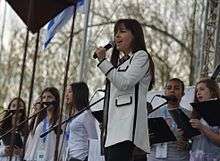
2015 Recording of "Lay Down Your Arms":
To mark the 70th anniversary of the end of World War II in Europe, the Habonim Youth Choir and the March of the Living Children's Choir, recorded a new version of "Lay Down Your Arms". Cantor Aviva Rajsky and guitarist Tom Bellman - from Toronto's Congregation Habonim - composed a new arrangement for the song. It was first performed on Holocaust Remembrance Day, at the 2015 March of the Living ceremony in Auschwitz-Birkenau.[18]
Partnership with other organizations

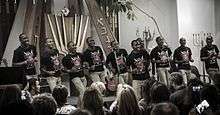
The synagogue makes its facilities available to a number of other organizations, including Ve'ahavta, co-sponsoring a Passover Seder for the Homeless[19] every year and the Toronto Partnership Minyan,[20] an Orthodox egalitarian initiative in Toronto spearheaded by Professor Martin Lockshin, and has co-sponsored events with other organizations outside the Jewish community such as Free the Children and Me to We,[21] producing a joint event featuring the Kenyan Boys Choir.
It is also home to Canada's only multi-denominational introductory conversion course.[22]
Synagogue interior
The synagogue windows are made of stained glass created by modern-day master Gerald Tooke (1931-2011), considered among Canada's leading practitioners of the craft. His work may also be seen at Mount Allison University Chapel in Sackville, N.B, Ontario's legislative buildings in Toronto, and in many churches and other buildings across Canada, said to number around 100 in all.[23]
The distinctive ark was designed by celebrated Canadian sculptor May Marx.[24] The ark was manufactured and installed by longtime synagogue member Alfred Altman, himself a refugee from Düsseldorf Germany. While he escaped Düsseldorf on the Kindertransport in 1939, both his parents were murdered in the Holocaust and now have Stolperstein monuments placed in their memory in front of their former home.[25][26][27]
New building
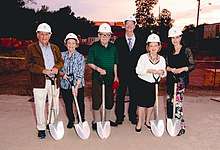
In 2015, amidst a growing membership and religious school the synagogue launched a new building campaign to replace its decaying structure, aimed at raising 9.5 million dollars, later revised to 13.5 million. As of early 2018, 12 million of its fundraising goal had been reached. Groundbreaking took place in the summer of 2018, with completion taking place in the fall of 2019 in time for the 2019 High Holidays.[28]
“I feel a great sense of pride that I have been able to be even a small part of the process that is leading Habonim into a new era. I love the clean simplicity of the design. I feel we have been able to maintain the humble beginnings of our congregation in a beautiful new building that speaks to the future.,’" Habonim President Joanie Smith said in an interview with the Canadian Jewish News in November of 2019. [29]
References
- Goldberg, Adara Ruth R. We were called Greenies : Holocaust survivors in postwar Canada (Ph.D.). Clark University. p. 176. OCLC 820730194.
- Stern, Cara (2 November 2012). "Spiritual leader helps build a stronger community". Canadian Jewish News. Retrieved 31 March 2014.
- Lungen, Paul (6 December 2013). "German Jew hunted down Kommandant of Auschwitz". Canadian Jewish News. Retrieved 31 March 2014.
- "Knights of Pythias Judea Lodge". UJA Federation of Greater Toronto.
- Gladstone, Bill. "Landsmanshaft and Jewish mutual benefit societies of Toronto". Jews of Toronto. Retrieved 1 April 2015.
- Esther Ghan. The Canadian Encyclopedia. Historica Dominion Institute. 16 December 2013. Retrieved 31 March 2014.
- Rose, Ben (7 March 2012). "Obit: Rabbi Reuben Slonim (d. 2000)". Retrieved 31 March 2014.
- "Booklet for Henry Weingluck's 75th birthday". Archived from the original on 2014-03-03. Retrieved 2014-02-26.
- "Avrum Rosensweig". Cite journal requires
|journal=(help) - "Ve'ahavta".
- "Habonim Youth Choir records "Lay Down Your Arms"". Archived from the original on 2014-01-04. Retrieved 2019-07-08.
- Lay Down Your Arms.
- "Gorbachev's Revolution". Archived from the original on 2014-03-07. Retrieved 2014-03-07.
- "Eli, Eli".
- David Kaufman, documentarian.
- To Live and Die with Honor.
- "Jose Feliciano performs in Toronto for guide dog program".
- Lay Down Your Arms - 2015 March of the Living. YouTube.
- "Passover Seder for the Homeless". Archived from the original on 2014-03-02. Retrieved 2014-02-26. Cite journal requires
|journal=(help) - "Toronto Partnership Minyan".
- Free the Children Me to We.
- "Multi-denominational introductory conversion course".
- "Through the glass brightly".
- "Her Art Makes Big Marks".
- "Because That's What You Do": A Habonim Kristallnacht Story" (PDF).
- "Stumbling Stones Blumenstraße 9".
- "Alfred Altman(n) (1921-2001) /Barbara Suchy". Archived from the original on 2015-02-20. Retrieved 2015-02-20.
- "Habonim Building Update" (PDF). Congregation Habonim Bulletin. 64 (3). June 2017.
- Rosensweig1. "ROSENSWEIG: OUT OF THE ASHES OF KRISTALLNACHT, A SHUL IS BORN".